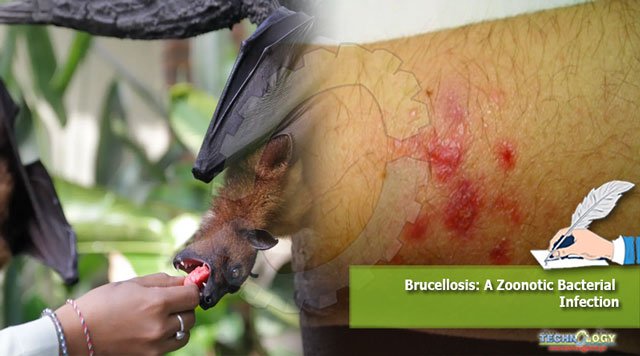Brucellosis is a zoonotic bacterial disease transmitted from animal to human-caused by the genus Brucella.

Dr. Maria Jamil1, Dr. Aisha Khatoon1, Dr. Muhammad Kashif Saleemi1, Dr. Muhammad Tahir Aleem2
- Department of Pathology, Faculty of veterinary science, University of Agriculture, Faisalabad
- MOE Joint International Research Laboratory of Animal Health and Food Safety, College of Veterinary Medicine, Nanjing Agricultural University, 210095 Nanjing, P.R.China
Brucellosis is a zoonotic bacterial disease transmitted from animal to human-caused by the genus Brucella. Usually, humans are infected through eating and drinking of raw and unpasteurized dairy products. However, bacteria abortus that leads to brucellosis in cattle may be transmitted through the air and by direct contact with diseased animals. Brucellosis is also known as Mediterranean fever, undulant fever, gastric remittent fever, and Malta fever. Humans are accidental hosts, but worldwide, brucellosis is the major public health concern and common zoonotic disease. Brucellosis symptoms in humans include fever, fatigue and joint pain. The infection is normally cure with antibiotics, while treatment may take many weeks to months, and infection mayreappear. Worldwide brucellosis can infect hundreds and thousands of animals and humans. Brucella organisms that are small aerobic intracellular coccobacillus localized in the reproductive tract of host animal leads to sterility and abortion. They are mainly shed in milk, urine, placental fluids, and other fluids. However, the human can suffer from devastating non-specific illness and localized involvement of several organs.
Brucellosis in cattle and other Bovinae is mainly produced through Brucella abortus, a Gram-negative coccobacillus, and short rod shape bacteria belonging to family Brucellaceae and class Alphaproteobacteria.
Cattle frequently obtain the Brucella abortus through contact with organisms in vaginal discharges, placenta, fetus, and fetal fluids from infected animals. By mucous membranes, ingestion and spread are thought to be the main route, while organisms may also enter in the body through injured skin. In several cases, cattle remain infected for a year. They may shed Brucella abortus whether they abort or carry the pregnancy, and reinvasion of the uterus may occur during consequent pregnancy. This organism is also shed in urine, semen, and milk. Shedding in milk is intermittent, and mammary glands are commonly colonized during systemic infections while the organism may also enter into the teats through the environment. In cattle, natural meetings does not appear to be the main route of spread, while venereal spreads seem to be more effective when Brucella abortus is depositing in the uterus and during artificial insemination, polluted semen might introduce this organism. Contaminated syringes are also the iatrogenic source of spread. In blood-sucking arthropods like sucking lice and ticks, Brucella abortus has also been observed.
Humans acquired this infection through the ingestion of organisms and by polluted mucous membranes includes conjunctiva and respiratory tract, and also through abraded skin—person to person spread by bone marrow transplantation, blood transfusion, and exposure to pollutened material. However, there is no evidence that Brucella abortus is spread among people through casual contacts.
Brucella abortus can be transmitted through fomites include feed and water. Brucella species may alive in the environment for a day to more than 8 months depends on temperature, humidity, sunlight, and presence of organic matter. High humidity, low temperature, and sunlight lead to longer survival of this organism in water, manure, aborted fetus, wool, hay, etc.
Sign and symptom of brucellosis: Brucellosis signs and symptoms may appear after a few days to a month of infection.
- Intermittent fever, chill, fatigue
- Inappetence, sweating
- Joint and back pain
- Headache and weight loss
Causes of Brucellosis: Several domestic and wild animals are susceptible to cause the brucellosis in human, which includes:
- Cattle, sheep, goat
- Dogs particularly that are using in hunting
- Deer, bison pig and wild hogs
- Moose and camel
The ways through which Brucella abortus transmitted from animals to humans include:
- Eating and drinking raw and unpasteurized dairy products
- Inhaled polluted air
- Through blood and body fluids of diseased animals
- Also spread through person-person and, in some cases, from mother to children during birth and through breast milk. Occasionally through sexual activity and contaminated blood and bone marrow transfusion.
Risk factors: Brucellosis is rare in the United States and common in other countries like South Europe, Eastern Europe, Mexico, South and Central America, Asia, Africa, and the Middle East. In these countries, people are more liked to eat unpasteurized goat cheese, also known as village cheese, is the main source of this infection.
Risk is usually high in people who are in contact with animal urine, blood, and tissues. The animal placenta can be infected with Brucella abortus. People might be exposed to bacteria when help in parturition of the animal. However, Brucella is occasionally transmitted by casual contact with pet animals.
Occupations at risk:
- Veterinarian, dairy farmers, and ranchers
- Slaughterhouse worker, hunters, and microbiologist
- Mainly the people who work with animals or in contact with infected blood are at more risk of brucellosis.
Diagnosis of brucellosis:
- Diagnosed the disease through testing blood, bone marrow, urine for Brucella bacteria, or through testing blood for antibodies to bacteria.
- X-rays, computerized tomography (CT) scan, and magnetic resonance imaging (MRI)
- Cerebrospinal fluid culture and Echocardiography
Treatment and Prevention:
- Eat and drink unpasteurized dairy products
- Cooked meat thoroughly from 145-165F (63-74C)
- Wear gloves and take safety precaution in high-risk workplace
- Vaccinate domestic animals
The purpose of brucellosis treatment is to relieve symptoms and avoiding a relapse of infection, and prevent contamination. Take antibiotics for at least 6 weeks, such as rifampin and doxycycline. The infection can reappear and become chronic.
Zoonotic Potential: Brucella abortus has zoonotic potential. However, live attenuated organisms in strain 19, and RB51 vaccines are also considered pathogenic for human beings, while RB51 seems to be safer than strain 19.
